Abstract | PDF | UnDisciplined (Feb 2020) | Request Permissions
Representing Dogs as Rational Near-Equals in Eighteenth Century British Portraiture
Luba Stephania Kozak
Biography | Notes
Keywords: Portraiture, Posthumanism, Unconventionality, Animal Rationality, Identity
Introduction
The category of the ‘pet’ rose in popularity in eighteenth century Britain, allowing for more intimate relationships with non-humans to develop. Pets were perceived less as working animals or emblems and more as valuable family members with distinct identities. At this time, enlightenment ideas revolved around notions such as freedom of thought and reason, while a social rhetoric of sensibility encouraged people to sympathize with non-humans. These factors enabled people to think differently and for some, to extend the notion of reason to animals. The visual arts offered a space where such new ideas regarding human and animal relations could be explored, as well as a place to contemplate controversial views on the mental capabilities of animals.
Through an interdisciplinary approach that combines the fields of art history, philosophy, and animal studies, my research examines the change in social attitudes towards animals as portrayed in eighteenth century British portraiture with a primary focus on the unconventional modes of representation in Thomas Gainsborough’s (1727–1788) portrait of Henry Scott, Third Duke of Buccleuch (c. 1770, Figure 1). By examining the social attitudes towards pets in eighteenth century Britain, my study discusses the elevated status of dogs in Britain’s early modern visual culture, which offers new possibilities for understanding the complex and sympathetic relationship between owners and their pets.
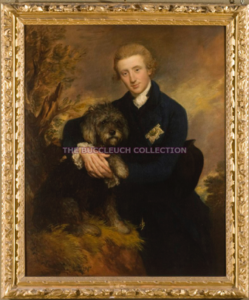
By reconstructing the identity of the Dandie Dinmont Terrier dog in Gainsborough’s portrait of Henry Scott, an alternative narrative for the painting is presented which acknowledges the dog’s near-equal role of importance in relation to the human subject.[1] I apply contemporary discourses on animal ethics and posthumanist theory, as well as early modern philosophies, to my analysis of the portrait, with a primary focus on the influential writings of the eighteenth century philosopher, David Hume (1711–1776). Central to my research is an exploration of Gainsborough’s rejection of iconographic convention, which complicates the categorization and meaning of the portrait within a specific subgenre of portraiture.
Theoretical Framework and Methodology
My theoretical framework of post-humanism challenges humanist ideals and anthropocentric views, shedding light on a subject that has often been marginalized in Western art history because of its non-human status. My analysis of Henry Scott reveals what art historian Maria Pointon calls “ideological mechanisms”[2] that are embedded in portraiture. I argue that in this case, they point to a progressive view of canine companions as rational near-equals and unique extensions of human identity.
The term ‘near-equal’ is not the perception of the dog in Henry Scott as having the identical social status as an adult male human or having anthropomorphized features. Instead, I use the term to address a recognition of the animal’s sentience, agency, identity, and capacity for reason. I argue that this recognition elevates the dog’s role to that of a near-equal conscious individual in the painting. By breaking with iconographic convention that marginalized the role of pets in earlier portraits, Gainsborough provides the spectator with greater character insights to both the human and non-human subjects in Henry Scott. In doing so, Gainsborough offered commentary on the evolving perspectives towards animals and suggested a destabilization of anthropocentric ideals.
My research also explores how human and canine identities in Henry Scott rely on social modes, such as the construct of gender and species roles, which contributes to a philosophical system that emerges based on an equalizing effect from the interdependency between the two subjects. My methodology centers on an interdisciplinary analytical discourse approach that offers an alternative interpretation for the painting and the inter-species relationship portrayed. I use a method of comparison to best demonstrate how Gainsborough broke with iconographic expectations by comparing the portrait of Henry Scott with other works by Gainsborough and those of his contemporaries.
My study is inspired by the work of many scholars and the evolving discourses in the field of contemporary animal-rights, which have highlighted the importance of human attitudes towards animals. In his book The Cry of Nature, Stephen Eisenman discusses the prejudices towards animals that have stemmed from a humanist tradition in the visual arts.[3] However, Eisenman combines both the fields of animal-rights and art history to demonstrate how early modern thinkers and artists began to express sympathetic attitudes towards animals, perceiving them as sentient and conscious beings.[4] Additionally, Eisenman combines modern scientific findings on the issue of animal rationality along with the theories of early modern thinkers (including René Descartes and David Hume).
The post-humanist theories of Pramod Nayar and Donna Haraway have further revealed the construct of anthropocentric and speciest politics, as well as the importance of recognizing the interconnectivity between humans and non-humans.[5] Nayar focuses on a “critical posthumanism” framework, which critiques traditional humanist theories that are exclusive to non-humans.[6] An inclusive critical posthumanism thus frames the lens through which I analyze the subjects in Gainsborough’s portrait of Henry Scott and attribute both subjects with a sense of self-awareness and consciousness.
Historians Ingrid Tague and Erica Fudge have been prominent in scholarship on eighteenth-century human and animal relations.[7] As Fudge and Tague would agree, because we do not have access to an animal’s experiences, scholars cannot study non-humans as isolated subjects in the same way a human subject can be studied. However, Fudge implies the possibility for new ways of studying historical non-humans through the human who provides access to the animal: “Reading about animals is always about reading through humans.”[8] Thus, my analysis of the human subject in the portrait of Henry Scott provides insight about the dog. While both scholars explore the animal only through its impact on human life, they do not focus on the individual animal as a real and historical figure in the visual arts, thus inspiring my research topic.
In his book The Animal Therefore I Am, the French philosopher Jacques Derrida examines the role of animals in philosophy, contemplating the consciousness of his cat who he embarrassingly undress in front of, addressing the idea of the real animal who looks back.[9] Derrida’s theory of the animal gaze thus influences the analysis of the dog in Henry Scott, who I argue is presented looking back at the spectator not as an unconscious symbol, but as a real individual with emotions, thoughts, and agency.
Surprisingly, not much has been written on the portrait of Henry Scott, other than a brief analysis of the work within larger scholarly texts. Some scholars including Diana Donald and Erica Fudge have noted the unconventional representation of near-equality in the painting, but have not elaborated or pursued the implications of its meaning further.[10] In their work on Gainsborough, art historian James Hamilton and biographer William Whitley portray the artist as only profit-driven, arguing that he did not make personal commentaries on social or political issues in his art.[11] Although Gainsborough’s commentaries were less provocative than those of his mentor, artist William Hogarth (1697–1764), they are nonetheless present.[12] The unsurpassed rendition of the intimate bond of companionship expressed in Henry Scott distinguishes the painting from any of Gainsborough’s other works and from any other portrait involving human and non-human subjects of the era or earlier. I contend that Gainsborough’s keen aptitude for observation and ingenious skill for depicting the likeness and inner character of his sitters in Henry Scott, as well as the opportunity to collaborate with an open-minded patron with similar progressive views on canine companions, led the artist to paint a truly different understanding of his sitter’s identities.
Henry Scott and Features of Male Portraiture
Henry Scott (1748–1812) was a wealthy landowner and army officer. He married Lady Elizabeth Montagu (1743–1829) and after generations of absence was the first to return to Scotland to take the principle Buccleuch family seat at Dalkeith Palace, near Edinburgh. Henry Scott helped revitalize the Scottish economy by encouraged Scottish manufacturing and petitioned against government involvement in Scottish elections.[13] In 1783, Henry Scott was elected the first president of the Royal Society of Edinburgh. The portrait of Henry Scott was originally commissioned for the Royal Society of Edinburgh, but rejected because the dog was deemed “inappropriate.”[14] This reception of the painting by the Royal Society of Edinburgh demonstrates the impact that the unusual portrayal and controversial ideas put forth in the work had on eighteenth-century spectators. The formal commissioning of the painting also suggests that the work was intended as a sincere representation of the Duke, highlighting the importance of a closer analysis of the unconventional modes of representation that challenge the context of the portrait.
Although there are other portraits of Henry Scott, Gainsborough’s portrait of the Duke is significant because it represents the young nobleman during a very important time in his life: the Duke’s coming of age and the full inheritance of all his estates. In the portrait of Henry Scott, Gainsborough painted both subjects in the foreground of the work, against an outdoor autumn setting. The young Duke is portrayed respectably, dressed in a fashionable dark coat with the Order of the Thistle pinned on his left breast and his hat tucked under his arm.[15] In the painting, Gainsborough depicted the Duke in a relaxed pose with his shoulders at ease, head tilted in a friendly manner, and his arms tenderly wrapped around his dog.[16] In comparison to the rigid formality of the subject in Joshua Reynolds’s (1723–1792) portrait of Lord Heathfield of Gibraltar (c. 1787, London, National Gallery, NG111), the casual pose of the Duke and emphasis on emotion by embracing the dog in Henry Scott conveys an informal tone. Gainsborough softens the effect of grandeur in the portrait by positioning the Duke in a relaxed posture instead of in an overbearing stance, creating a friendly and inviting tone. In the painting, the charcoal-coloured, shaggy-furred dog is portrayed in a state of alert focus and is placed on a raised patch of dirt. Gainsborough added compositional complexity to the painting by positioning the dog’s paw on top of the Duke’s hands.
The genre of early-modern portraiture sought to capture the character and social achievements of the subjects, offering greater insights about an individual than any other genre of art.[17] In the portrait of Henry Scott, Gainsborough captured something beyond the likeness of his sitters. He depicted a timeless friendship that remains relatable centuries later. Yet, Thomas Gainsborough’s portrait of Henry Scott is the most unconventional example of male portraiture of the era because of its intimate representation of the relationship between a man and canine, as well as the sense of near-equality between a human and non-human. This is especially extraordinary considering that this was a time when British society was struggling to define what it meant to be “human.”[18] As Fudge discusses in Perceiving Animals, early modern British society debated whether humanity was distinctly separate and superior from the natural world (especially from animals), while others argued the opposite.[19] However, rather than succeeding in creating a succinct divide between humans and nonhumans, a series of discourses around human and animal relationships transformed definitions of human identity.
The use of pictorial metaphors such as the Order of the Thistle and fashionable attire contributes a formal element to the portrait and articulates the Duke’s dignified social standing; categorize the work as a grand manner portrait.[20] Yet, the inclusion of the dog in such a prominent role and intimate pose complicates the Duke’s image and the subject matter. When comparing Henry Scott with other male portraits by Gainsborough and those of his contemporaries, how Gainsborough broke with iconographic standards can be observed. For example, in Gainsborough’s competitor Joshua Reynolds’s portrait of Lord Heathfield of Gibraltar, the male sitter is represented with symbols of military achievement that dominate the subject matter of the painting. In the portrait of Henry Scott however, the Order is perceived more as a pictorial accessory and is painted on the same visual plane as the dog; therefore it is impossible to see one without the other. The dog is thus understood to contribute significant insight about the Duke’s character, making him a vital extension of the Duke’s identity and an important figure as well.
Gainsborough was renowned for his ability to paint beautiful costumes and was particularly concerned with lighting. In Gainsborough’s portrait of Robert Craggs (c. 1760–1, private collection), the artist paid careful attention to the details of the sitter’s coat, emphasizing the effects of light. Although the style of navy coat in both paintings is similar, the lack of attention to lighting makes the Duke’s coat in Henry Scott appear dull and simplistic. This unusual aspect in the painting suggests an intentional compositional decision to draw the spectator’s attention away from materialistic distractions to a more important matter: the Duke’s relationship with his dog. At the time Henry Scott was painted, Gainsborough admitted in a letter to a friend that he was tired of the pressures of society portrait painting.[21] The portrait of Henry Scott may have offered Gainsborough a more conceptually engaging topic as an intellectual break of sorts.
Although the Dandie Dinmont Terrier in Henry Scott can be perceived as an objectified fashionable accessory in the portrait due to the eighteenth century perception in Britain of pets as luxury consumer goods, the dog is also a consumer of fashion, which elevates its status.[22] Similar in purpose to human clothing, animal fashion indicated status.[23] In the painting, the dog is accessorized with a leather collar, detailed with a glistening gold buckle made intentionally visible and not covered by the dog’s hair. Just as fashion contributes to inform the Duke’s social identity, the collar also informs the dog’s identity and symbolizes ownership, which materialistically associates the dog with the Duke. But rather than constructing ownership as an oppressive notion, the collar indicates that the dog’s status is elevated from that of a stray to the pet of a nobleman.
As in contemporary society, collars in the eighteenth century also conveyed an owner’s concern for the safe return of their lost pet.[24] In Henry Scott, beyond its fashionable purpose, the collar thus further symbolizes the Duke’s doting care and concern for his beloved companion. This intimate relationship between the Duke and the Dandie Dinmont Terrier challenges the perception of the dog as merely a fashionable accessory in the painting.
Identity, Nationalism, and Landscape
The non-marginalized and engaged role of the dog in Henry Scott presents the dog as a significant actor in the painting. As art historian Shearer West writes, “‘Identity’ can encompass the character, personality, social standing, relationships, profession, age, and gender of the portrait subject.”[25] Based on this premise and an analysis of the canine subject in Henry Scott, I examine how the dog is represented with attributes that inform its identity, such as the visual portrayal of its personality and relationship with the Duke. I argue that the notion of “identity” in Gainsborough’s portrait of Henry Scott is evident in both the human and non-human subjects.
I argue that the subjects in Henry Scott serve as extensions of each other’s identities. Bred from a mix of terriers, including the Bedlington, Scottish, English, and Otter Hound,[26] I propose that the Dandie Dinmont breed embodies the merging of both Scottish and English cultural identities. At the time Henry Scott was painted, the Duke was experiencing a change between the familiarity of his English identity and an emphasis on his new Scottish identity after moving to Scotland to take the principle Buccleuch family seat. I suggest that the dog thus symbolizes an extension of the Duke’s national identity in the portrait by portraying the merging of cultural identities. However, as art historians Michael Rosenthal and Martin Myrone write, “The dog is an individual character in its own right, emphasized by it being an unusual breed, possibly a Dandie Dinmont Terrier…”[27] Therefore, the distinct Dandie Dinmont Terrier breed also contributes to the uniqueness of the dog’s own identity and demonstrates how the notion of nationality crosses interspecies boundaries to inform a non-human animal’s identity.
Gainsborough was also a remarkably talented landscape artist, a genre that he preferred to portraiture. Considering that Duke Henry and his new wife traveled through many miles of their newly acquired lands in Scotland, the lack of a depiction of property wealth or landscape depth in Henry Scott is unusual, unlike in Gainsborough’s earlier portrait of Mr. and Mrs. Andrews (c. 1750, Figure 2). I argue that the compositional decision to keep the landscape in Henry Scott simplistic conveys the artist and patron’s decision to focus on the human-canine relationship instead of conventional modes of representing status and wealth. In Henry Scott, the Duke blatantly abandons social expectations and intimately interacts with his dog, which challenges social etiquettes and constructed hierarchies of power. Although it is unclear who commissioned the painting of Henry Scott, it is presumable that the Duke agreed to be represented in such an unconventional way, aware of the criticism the painting would receive from upper-class spectators, as well as Gainsborough’s contemporaries. The extraordinary impression that the unconventional modes of representation in Gainsborough’s Henry Scott had on eighteenth-century critics is made evident in an entry note for the painting in “Catalogue of Pictures at Dalkeith House,” published in 1911. The catalogue entry reads: “This picture was originally painted for the Royal Society, Edinburgh, but refused by them because of the dog, which they thought inappropriate.”[28] In comparison, Mr. and Mrs. Andrews exemplifies a more conventionally accepted masculine mode of representing dogs: as hunting, working animals near the foot of their master.
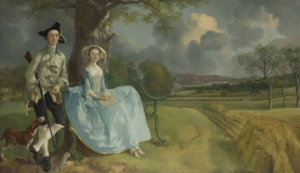
Iconographic Portrait Comparisons
There is a striking similarity between the portrait of Henry Scott and portraits of children with pets.[29] In the eighteenth century, children were perceived as not quite human, therefore child-with-pet portraits conveyed equality through similarities, such as in Joshua Reynolds’s portrait of Sophia Matilda of Gloucester (c. 1774–1777, Figure 3).[30] Eighteenth-century portraits of children also convey a sense of innocence that is abandoned in most grand portraits of adults in the same era. In comparison, adult sitters were commonly represented as authoritative, contemplative, and rigidly posed in formal manners. However, in Henry Scott we are reminded of a child-like innocence through the informal and affectionate relationship portrayed between the Duke and his canine companion, which is particularly unconventional because of the Duke’s adult age. But Henry Scott is not a child, which complicates the work since adult men were perceived as being rational; thus the sense of near-equality in the work also challenges the spectator to extend the notion of rationality to the non-human subject as well.
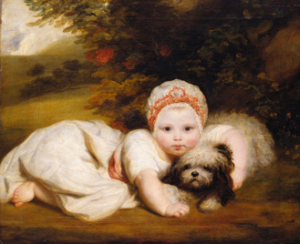
A more appropriate iconographic comparison with Henry Scott is mother and child portraits, given the Duke’s feminized role and adult age in the painting. In Henry Scott, the dog takes on the role of the child and the Duke that of a parent protectively embracing his dog, which feminizes him only in the sense that he takes on a conventional motherly role.[31] In one way, the Duke’s masculinity is challenged by an outward portrayal of affection that was more common in female portraits of the era.[32] Alternatively, the Duke’s affection for his dog was also recognized as an acceptable masculine feeling in eighteenth century Britain.[33] As Tague suggests, the Duke’s male identity adds masculine weight to the painting to establish a sense of friendship between equals.[34] The Duke’s association with a pet of the canine species further conveys the Duke’s masculinity in the painting since dogs were gendered male appropriate and cats were typically gendered female.[35] Therefore, the relationship portrayed between the Duke and his dog in Henry Scott complicates the notions of conventional gender and species role representations in early modern portraiture.
A fascinating comparison in my research is the representation of the same Dandie Dinmont dog in Joshua Reynolds’s (1723–1792) portrait of the Duke’s wife and daughter, Elizabeth, Duchess of Buccleuch and Child (c. 1772, Figure 4). In comparison with Gainsborough’s portrait of Henry Scott, Reynolds’s painting portrays the dog as a conventionally marginalized and emblematic subject, emphasizing the unusually intimate relationship between the Duke and his dog in Henry Scott. Reynolds’s Elizabeth, Duchess of Buccleuch and Child also demonstrates conventional mother and child iconographic expectations that draw parallels with the dog’s child-like role in Henry Scott. I propose that the dog is represented as a child-like substitute in the portrait of Henry Scott since the status and roles of pets and children were analogous. The flexibility of the constructed notions of “family” and “childhood” at this time enabled the dog to assimilate into the family unit and assume a child-like role.[36]
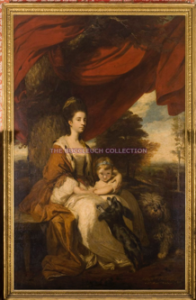
Although the rhetoric of sensibility made it acceptable for men to express their feelings for non-humans, the portrait of Henry Scott pushes the boundaries of anthropocentric and masculine ideals. But to impose gender politics on the portrait of Henry Scott is also problematic because the relationship portrayed is at the convergence of gender and species politics. Instead, the portrait creates a new space for an alternative understanding of human-animal relations.
Competing Philosophies
The seventeenth-century French philosopher René Descartes argued that animals were emotionless organic machines that lacked consciousness because they did not have souls.[37] However, many philosophers refuted Descartes’s negative views towards animals, including David Hume who argued that animals have emotions, rationality, and even shared resemblances with humans.[38] Hume argued that if there are observable parallels between human and animal anatomies, then the same considerations should be given to the animal mind.[39] Other eighteenth century British thinkers like William Smellie and Erasmus Darwin also argued that animals were capable of reason and a range of emotions through facial expressions and body gestures.[40] The Duke’s library records included works by Hume; therefore my research proposes that Hume’s arguments in favour of animal rationality directly influenced the Duke’s perception of non-humans.
My research centers on an exploration of how the dog in Henry Scott articulates a capacity for rationality through visual clues, such as a state of “nervous affection” and self-interested behaviour rather than an idealized, doting expression that is more common of dogs in other works.[41] I define “nervous affection” as the dog’s response through facial and body expressions to its uncomfortable position of being embraced, which is a state of toleration and patience that comes with accepting the Duke’s affection. Furthermore, I argue that the Dandie Dinmont Terrier gazes back at the spectator, demonstrating a sense of self-awareness and consciousness.
Although Gainsborough created an endearing sense of intimacy in Henry Scott by portraying the Duke embracing his dog, the notion of dominance remains present. As human-geographer Yi-Fu Tuan writes, dominance combined with affection produces the category of the pet.[42] To elaborate, the dog is understood as a domesticated pet that asserts the Duke in a position of human dominance over the animal. However, the dog challenges the notion of dominance and regains power in the painting through the position of its paw overtop of the Duke’s arm, the weight of the paw even appearing to slightly lower the Duke’s arm. I argue that this unconventional compositional element places the dog in a role of power and establishes a sense of near-equality in the painting.
The popularity of pet-portraits in eighteenth century Britain highlighted the recognition of animal individuality and unique character traits. Gainsborough painted several of these types of works, including a portrait of his own dogs, Fox and Tristram (c. 1775-1785, Figure 5).[43] The painting Fox and Tristram exemplifies Gainsborough’s acknowledgement of canine individuality and capacity for rationality, which he expressed through the depiction of animal body language and facial expressions. For instance, Gainsborough depicted Tristram in a more relaxed pose in comparison with Fox whose stiff and tensed front paws conveys a sense of readiness. Gainsborough also provided more details in Fox’s facial expression, painting him with a lovable under-bite and white-speckled eyes. Fox’s illuminated eyes to create a direction for the animal’s gaze, which further express a sense of alert concentration; unlike Tristram whose dark eyes do not show any indication of the dog’s gaze and may even be closed.
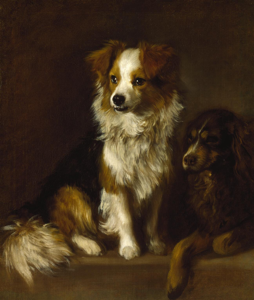
Animal Conversation Piece
In eighteenth-century Britain, the popular genre of conversation pieces conveyed family gatherings with pictorial details that enabled spectators to construct narratives about the subjects. Although this genre usually depicted more family members, I argue that the painting of Henry Scott should be considered an animal conversation piece because it presents the Duke and his dog as a family unit. Narratives about the characters of the sitters can also be drawn from the emotional bond portrayed.
Although the Dandie Dinmont Terrier in Henry Scott plays a significant role and shares an equal amount of attention in the portrait with the Duke, the Duke’s presence in the painting determines that the work cannot be considered a pet-portrait in its strictest definition. Art historian Malcom Cormack writes that Gainsborough had “sensitivity to the character of the dog” in the portrait of Bumper (c. 1745, private collection), which enabled the artist to depict the individuality of the dog.[44] Cormack defines Bumper as an “animal conversation piece” because it depicts the individual character of the dog and is one of the first recorded instances where Gainsborough reacted to the individuality of a non-human sitter.[45] I argue that Cormack’s premise thus offers an interpretive dimension for defining the subgenre of Henry Scott.
Pointon explains that eighteenth-century conversation pieces allowed for the articulation of social and familial decorum, noting that disconnected signs within the social situation related to cultural and political issues.[46] If Henry Scott is considered a conversation piece, then the “disconnected signs” that are the unconventional modes of representation in the portrait could be understood to point to a larger cultural commentary on the changing attitudes towards non-humans in eighteenth century Britain. I suggest that the disconnected signs, such as the elevated position and engaged role of the dog in the painting or the Duke’s intimate embrace of his dog that challenged social behavioural expectations, demonstrate a shift in the familial decorum of eighteenth century domestic life that enabled pets to rise in status.
Comparable Portraits
Prominent eighteenth-century English painters, including William Hogarth, Thomas Gainsborough, and Joshua Reynolds, frequently depicted humans and animals interacting with each other. These artists not only illustrated the companionship between humans and their pets in portraits, but also exhibited how the identities and narratives of the sitters could be constructed through cross-species relationships. In comparison with the portrait of Henry Scott by Thomas Gainsborough, I analyze both William Hogarth’s Self-Portrait with Pug (c. 1745, Figure 6) and Joshua Reynolds’s George Selwyn (c. 1766, private collection), portraits that also portray owners with canine pets. However, neither Hogarth nor Reynolds fully embraced the representation of the animal as a near-equal subject beyond representing the bond between owner and pet in the manner Gainsborough was able to accomplish in Henry Scott. Gainsborough achieved a much greater sense of intimacy in Henry Scott by portraying the Duke in the physical act of embracing his dog, which charges the painting with emotional and ethical implications.[47] By representing the Duke holding his dog in Henry Scott, Gainsborough emotionally charged the painting with notions of sentimentality that complicated social expectations of gender, age, and species roles. However, I propose that as Gainsborough’s mentor, Hogarth’s attitudes towards animals may have also had an early influence on the artist and inspired him to carefully consider the individuality of animals in his later works. The unconventional depiction of the dog as a near-equal rational and conscious subject makes Henry Scott a dynamic example of the progressive attitudes towards non-humans and acceptance of inter-species bonds in eighteenth century Britain. The portrait of Henry Scott is an unsurpassed masterpiece, both in regard to its content and stylistic characteristics as I have outlined in this paper.
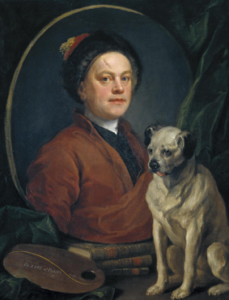
Conclusion
My study concludes with a discussion of the influence religious faith had on Gainsborough’s interest in moral issues regarding animals, as well as abstract multidisciplinary ways of thinking that shaped the artist’s progressive view of non-humans. In particular, I argue that Gainsborough’s Puritan values had a remarkable influence on the artist’s cross-species sentimentality. The emphasis on notions of emotion and “natural” sentiment that the Methodist faith preaches likely influenced Gainsborough’s representation of non-humans in paintings as subjects with emotional capacities. Biographer Alfred Fletcher accredits Puritanism with shaping Gainsborough’s character, suggesting that it was Puritan values that encouraged the artist to be “independent” and “original,” which I suggest also inspired the artist to break with social expectations and artistic convention.[48]
Later in his career, Gainsborough painted fancy pictures, which was a genre that depicted poor rural or urban low-life themes with narrative elements.[49] Animals emerged as key subjects in these paintings, but rather than only using conventional livestock animals, Gainsborough included pets, which made some of these paintings morally complex.[50] Gainsborough’s recognition of dogs as sentient and conscious animals (evident in earlier paintings like Tristram and Fox, Bumper, and Henry Scott) manifests more prominently in fancy pictures where the artist directly involved dogs in moral themes to evoke the spectator’s empathy for non-humans.
Gainsborough may not have realized that his moral and ethical considerations were shaped by philosophical discourses regarding animals that were developing in the early modern period. Although there is some scholarly debate about Gainsborough’s education, the rich moral issues portrayed in his fancy pictures demonstrates that the artist was indeed engaged with philosophical matter.[51]
In eighteenth-century Britain, non-human animals were objectified and perceived as fashionable accessories and indicators of status and wealth. Yet, as in the case of pets, the new role of animals in early modern British society enabled entirely new ways of interacting and perceiving domesticated animals, at times elevating the animal’s status. By representing the dog as a near-equal subject in Henry Scott, Gainsborough draws attention to the construct of the non-human subject’s status and place within society. As a result, Gainsborough conveys to the viewer the idea that how the non-human is perceived is a malleable social concept, which is a topic that remains relevant in contemporary fields of animal studies.[52]
Gainsborough’s portrait of Henry Scott was extremely unconventional for the era because of its display of male intimacy and sense of animal near-equality, challenging gender and species role expectations. As a result of breaking with convention, Gainsborough complicated the categorization of Henry Scott within the portraiture genre. However, the portrait of Henry Scott should be considered an animal conversation piece because it depicts the Duke and his dog as a family unit and narratives about the sitters can be constructed from pictorial details.
The intimate display of affection between an owner and his dog in Gainsborough’s portrait of Henry Scott is a tender representation of an inter-species bond that spectators centuries later have continued to relate to. Yet, the unconventional representation of the dog in Henry Scott as a near-equal subject in terms of rational capacity and importance challenges the iconographic standards of non-humans in early modern portraits that more commonly adhered to traditional humanist views that revolve around anthropocentric values. The unconventional representation of the Dandie Dinmont Terrier in Henry Scott as an individualized subject with a capacity for rationality and emotions demonstrates the influence of early modern philosophies regarding animals. Furthermore, the unconventional elements in the portrait of Henry Scott also highlights the complex status of pets in eighteenth century British society, as well as the expectation for owners to intimately know the characters of their non-human companions.
The unusual depiction of the dog as a near-equal subject in Henry Scott is unlike any other portrait of the era. By focusing the analysis on the canine subject in the portrait of Henry Scott—a subject often overlooked in art history studies because of its non-human status—I argue that Gainsborough represented the dog as an individual with affectations that suggest a capacity for rational thought and self-agency, emphasizing the near-equal status of both subjects in the painting. The representation of the dog as a conscious and present actor in Henry Scott thus demonstrates a shift away from the use of animals as merely symbolic or pictorial accessories in portraits.
Duke Henry’s relationship with and perception of his dog was directly influenced by the philosophies of David Hume as well as the rhetoric of sensibility that normalized the expression of sympathy towards non-humans in the eighteenth century, which Gainsborough sympathetically captured in the portrait. Finally, I argued that Gainsborough was appreciative of philosophy and indeed interested in morality, which can be observed in the artist’s fancy pictures, later in his career. The portrait of Henry Scott serves as an early example of Gainsborough’s exploration of moral and philosophical issues concerning animals that, in collaboration with a progressively open-minded patron, provides commentary on larger social changes in attitudes towards non-humans that were beginning to take place in eighteenth century Britain. By analyzing Henry Scott through a post-humanist lens, one that considers human morals and ethics, as well as acknowledges the significance of the unconventional role of the non-human in the portrait, modern spectators are reintroduced to one of England’s greatest artists and his noble patron. In this way, I propose an alternative way of understanding the canine subject in Henry Scott as a rational, sentient, and present individual worthy of the spectator’s attention. The dog is someone in the portrait of Henry Scott, not something.